Business Ethics Report: Analyzing Environmental Issues in Nepal
VerifiedAdded on 2022/11/16
|9
|2158
|267
Report
AI Summary
This business ethics report provides an in-depth analysis of environmental issues in Nepal, exploring the ethical challenges and implications for various stakeholder groups. It identifies key issues such as overpopulation, pollution, deforestation, and climate change, highlighting the role of corruption and lack of effective policies in exacerbating these problems. The report discusses the impact of rapid urbanization, the need for sustainable resource management, and the consequences of habitat degradation and biodiversity loss. It also examines the reasons behind corruption, particularly in the context of forestry and environmental protection. The report concludes by emphasizing the need for effective governance, transparent practices, and sustainable development strategies to mitigate environmental risks and promote a healthier environment for Nepal. The report is available on Desklib, a platform providing AI-powered study tools.

BUSINESS ETHICS
Paraphrase This Document
Need a fresh take? Get an instant paraphrase of this document with our AI Paraphraser

Contents
Introduction...........................................................................................................................................2
Analysis and discussion.........................................................................................................................2
Reason of corruption.............................................................................................................................3
Conclusion.............................................................................................................................................6
References.............................................................................................................................................7
Introduction...........................................................................................................................................2
Analysis and discussion.........................................................................................................................2
Reason of corruption.............................................................................................................................3
Conclusion.............................................................................................................................................6
References.............................................................................................................................................7
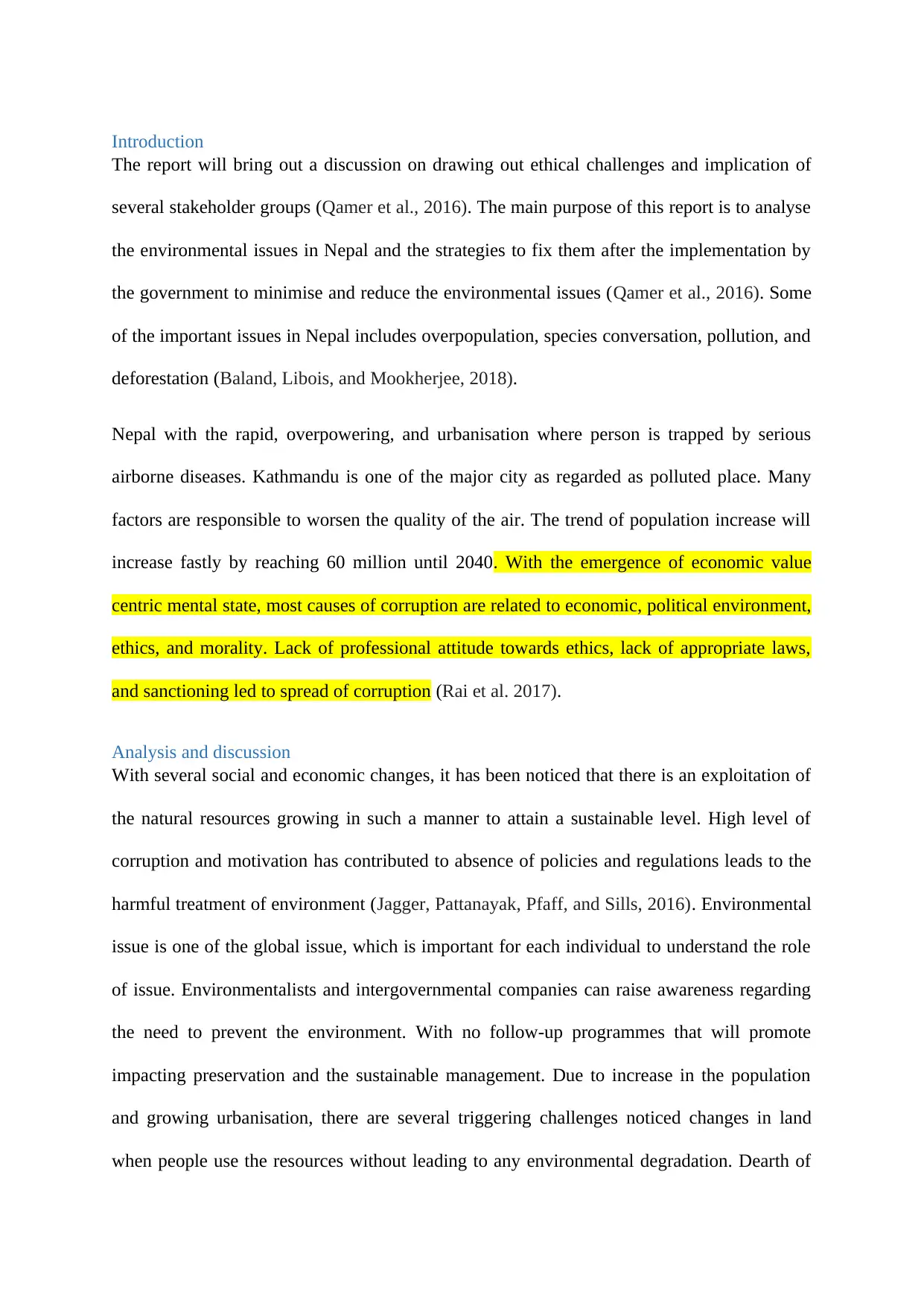
Introduction
The report will bring out a discussion on drawing out ethical challenges and implication of
several stakeholder groups (Qamer et al., 2016). The main purpose of this report is to analyse
the environmental issues in Nepal and the strategies to fix them after the implementation by
the government to minimise and reduce the environmental issues (Qamer et al., 2016). Some
of the important issues in Nepal includes overpopulation, species conversation, pollution, and
deforestation (Baland, Libois, and Mookherjee, 2018).
Nepal with the rapid, overpowering, and urbanisation where person is trapped by serious
airborne diseases. Kathmandu is one of the major city as regarded as polluted place. Many
factors are responsible to worsen the quality of the air. The trend of population increase will
increase fastly by reaching 60 million until 2040. With the emergence of economic value
centric mental state, most causes of corruption are related to economic, political environment,
ethics, and morality. Lack of professional attitude towards ethics, lack of appropriate laws,
and sanctioning led to spread of corruption (Rai et al. 2017).
Analysis and discussion
With several social and economic changes, it has been noticed that there is an exploitation of
the natural resources growing in such a manner to attain a sustainable level. High level of
corruption and motivation has contributed to absence of policies and regulations leads to the
harmful treatment of environment (Jagger, Pattanayak, Pfaff, and Sills, 2016). Environmental
issue is one of the global issue, which is important for each individual to understand the role
of issue. Environmentalists and intergovernmental companies can raise awareness regarding
the need to prevent the environment. With no follow-up programmes that will promote
impacting preservation and the sustainable management. Due to increase in the population
and growing urbanisation, there are several triggering challenges noticed changes in land
when people use the resources without leading to any environmental degradation. Dearth of
The report will bring out a discussion on drawing out ethical challenges and implication of
several stakeholder groups (Qamer et al., 2016). The main purpose of this report is to analyse
the environmental issues in Nepal and the strategies to fix them after the implementation by
the government to minimise and reduce the environmental issues (Qamer et al., 2016). Some
of the important issues in Nepal includes overpopulation, species conversation, pollution, and
deforestation (Baland, Libois, and Mookherjee, 2018).
Nepal with the rapid, overpowering, and urbanisation where person is trapped by serious
airborne diseases. Kathmandu is one of the major city as regarded as polluted place. Many
factors are responsible to worsen the quality of the air. The trend of population increase will
increase fastly by reaching 60 million until 2040. With the emergence of economic value
centric mental state, most causes of corruption are related to economic, political environment,
ethics, and morality. Lack of professional attitude towards ethics, lack of appropriate laws,
and sanctioning led to spread of corruption (Rai et al. 2017).
Analysis and discussion
With several social and economic changes, it has been noticed that there is an exploitation of
the natural resources growing in such a manner to attain a sustainable level. High level of
corruption and motivation has contributed to absence of policies and regulations leads to the
harmful treatment of environment (Jagger, Pattanayak, Pfaff, and Sills, 2016). Environmental
issue is one of the global issue, which is important for each individual to understand the role
of issue. Environmentalists and intergovernmental companies can raise awareness regarding
the need to prevent the environment. With no follow-up programmes that will promote
impacting preservation and the sustainable management. Due to increase in the population
and growing urbanisation, there are several triggering challenges noticed changes in land
when people use the resources without leading to any environmental degradation. Dearth of
⊘ This is a preview!⊘
Do you want full access?
Subscribe today to unlock all pages.

Trusted by 1+ million students worldwide
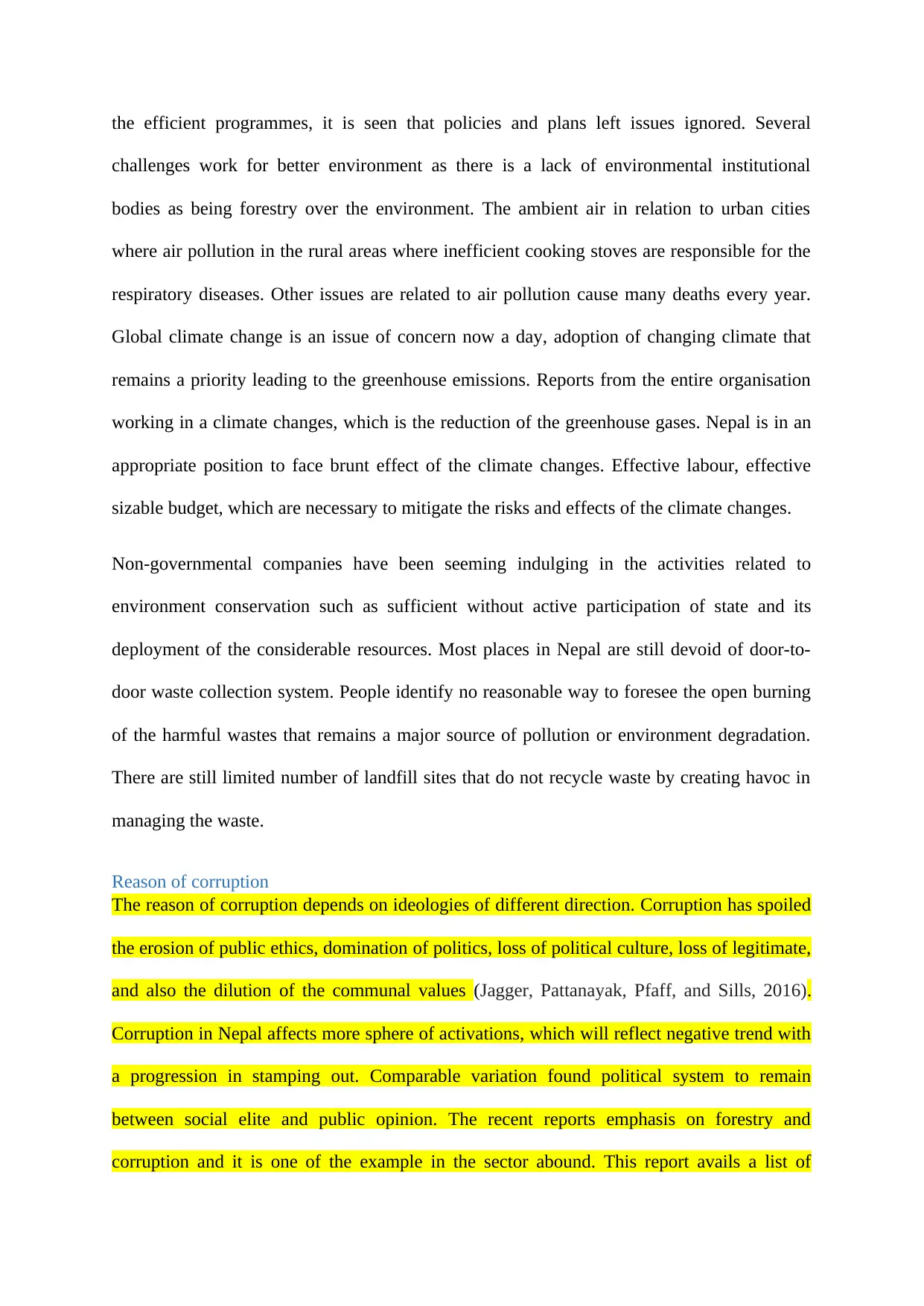
the efficient programmes, it is seen that policies and plans left issues ignored. Several
challenges work for better environment as there is a lack of environmental institutional
bodies as being forestry over the environment. The ambient air in relation to urban cities
where air pollution in the rural areas where inefficient cooking stoves are responsible for the
respiratory diseases. Other issues are related to air pollution cause many deaths every year.
Global climate change is an issue of concern now a day, adoption of changing climate that
remains a priority leading to the greenhouse emissions. Reports from the entire organisation
working in a climate changes, which is the reduction of the greenhouse gases. Nepal is in an
appropriate position to face brunt effect of the climate changes. Effective labour, effective
sizable budget, which are necessary to mitigate the risks and effects of the climate changes.
Non-governmental companies have been seeming indulging in the activities related to
environment conservation such as sufficient without active participation of state and its
deployment of the considerable resources. Most places in Nepal are still devoid of door-to-
door waste collection system. People identify no reasonable way to foresee the open burning
of the harmful wastes that remains a major source of pollution or environment degradation.
There are still limited number of landfill sites that do not recycle waste by creating havoc in
managing the waste.
Reason of corruption
The reason of corruption depends on ideologies of different direction. Corruption has spoiled
the erosion of public ethics, domination of politics, loss of political culture, loss of legitimate,
and also the dilution of the communal values (Jagger, Pattanayak, Pfaff, and Sills, 2016).
Corruption in Nepal affects more sphere of activations, which will reflect negative trend with
a progression in stamping out. Comparable variation found political system to remain
between social elite and public opinion. The recent reports emphasis on forestry and
corruption and it is one of the example in the sector abound. This report avails a list of
challenges work for better environment as there is a lack of environmental institutional
bodies as being forestry over the environment. The ambient air in relation to urban cities
where air pollution in the rural areas where inefficient cooking stoves are responsible for the
respiratory diseases. Other issues are related to air pollution cause many deaths every year.
Global climate change is an issue of concern now a day, adoption of changing climate that
remains a priority leading to the greenhouse emissions. Reports from the entire organisation
working in a climate changes, which is the reduction of the greenhouse gases. Nepal is in an
appropriate position to face brunt effect of the climate changes. Effective labour, effective
sizable budget, which are necessary to mitigate the risks and effects of the climate changes.
Non-governmental companies have been seeming indulging in the activities related to
environment conservation such as sufficient without active participation of state and its
deployment of the considerable resources. Most places in Nepal are still devoid of door-to-
door waste collection system. People identify no reasonable way to foresee the open burning
of the harmful wastes that remains a major source of pollution or environment degradation.
There are still limited number of landfill sites that do not recycle waste by creating havoc in
managing the waste.
Reason of corruption
The reason of corruption depends on ideologies of different direction. Corruption has spoiled
the erosion of public ethics, domination of politics, loss of political culture, loss of legitimate,
and also the dilution of the communal values (Jagger, Pattanayak, Pfaff, and Sills, 2016).
Corruption in Nepal affects more sphere of activations, which will reflect negative trend with
a progression in stamping out. Comparable variation found political system to remain
between social elite and public opinion. The recent reports emphasis on forestry and
corruption and it is one of the example in the sector abound. This report avails a list of
Paraphrase This Document
Need a fresh take? Get an instant paraphrase of this document with our AI Paraphraser
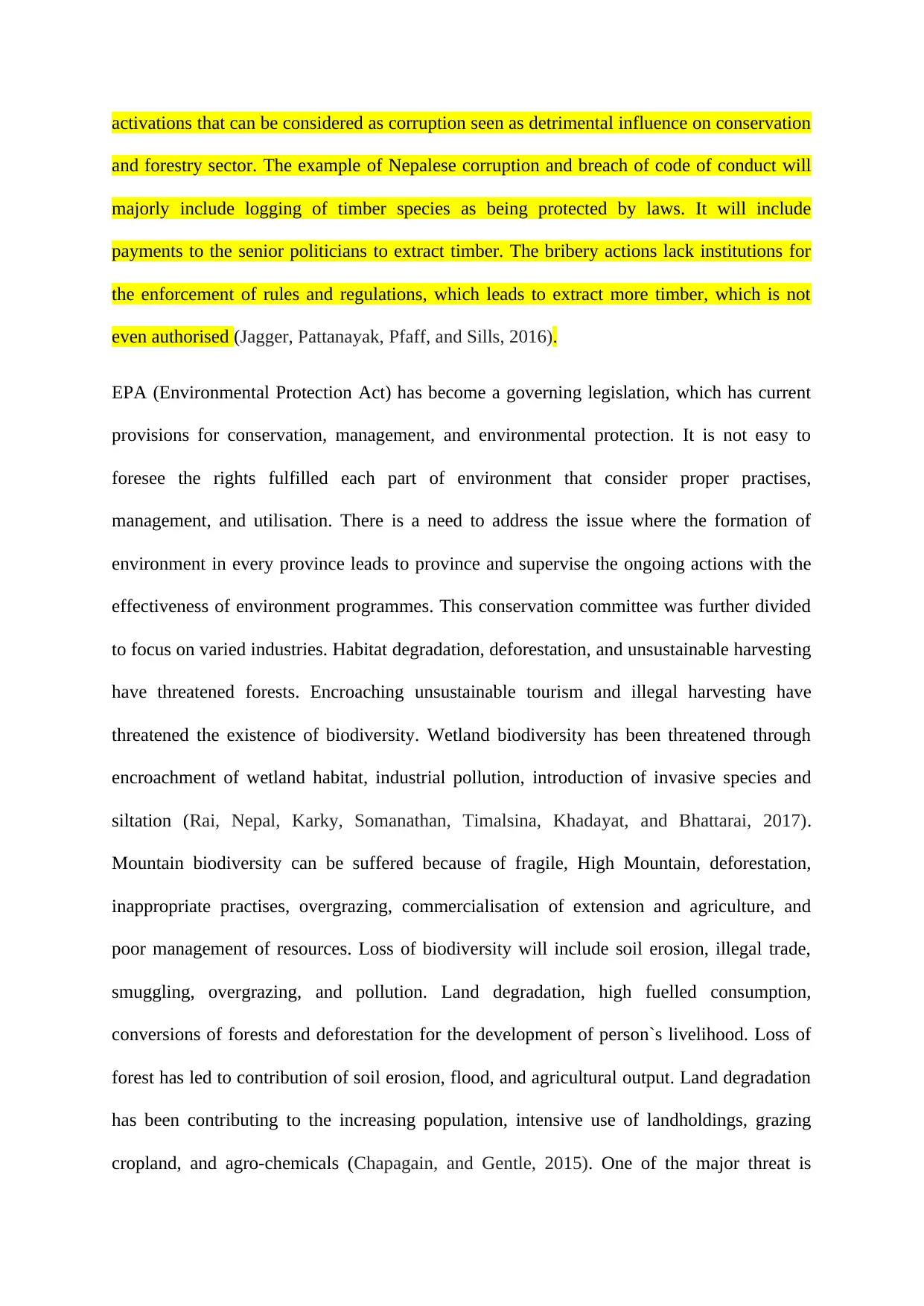
activations that can be considered as corruption seen as detrimental influence on conservation
and forestry sector. The example of Nepalese corruption and breach of code of conduct will
majorly include logging of timber species as being protected by laws. It will include
payments to the senior politicians to extract timber. The bribery actions lack institutions for
the enforcement of rules and regulations, which leads to extract more timber, which is not
even authorised (Jagger, Pattanayak, Pfaff, and Sills, 2016).
EPA (Environmental Protection Act) has become a governing legislation, which has current
provisions for conservation, management, and environmental protection. It is not easy to
foresee the rights fulfilled each part of environment that consider proper practises,
management, and utilisation. There is a need to address the issue where the formation of
environment in every province leads to province and supervise the ongoing actions with the
effectiveness of environment programmes. This conservation committee was further divided
to focus on varied industries. Habitat degradation, deforestation, and unsustainable harvesting
have threatened forests. Encroaching unsustainable tourism and illegal harvesting have
threatened the existence of biodiversity. Wetland biodiversity has been threatened through
encroachment of wetland habitat, industrial pollution, introduction of invasive species and
siltation (Rai, Nepal, Karky, Somanathan, Timalsina, Khadayat, and Bhattarai, 2017).
Mountain biodiversity can be suffered because of fragile, High Mountain, deforestation,
inappropriate practises, overgrazing, commercialisation of extension and agriculture, and
poor management of resources. Loss of biodiversity will include soil erosion, illegal trade,
smuggling, overgrazing, and pollution. Land degradation, high fuelled consumption,
conversions of forests and deforestation for the development of person`s livelihood. Loss of
forest has led to contribution of soil erosion, flood, and agricultural output. Land degradation
has been contributing to the increasing population, intensive use of landholdings, grazing
cropland, and agro-chemicals (Chapagain, and Gentle, 2015). One of the major threat is
and forestry sector. The example of Nepalese corruption and breach of code of conduct will
majorly include logging of timber species as being protected by laws. It will include
payments to the senior politicians to extract timber. The bribery actions lack institutions for
the enforcement of rules and regulations, which leads to extract more timber, which is not
even authorised (Jagger, Pattanayak, Pfaff, and Sills, 2016).
EPA (Environmental Protection Act) has become a governing legislation, which has current
provisions for conservation, management, and environmental protection. It is not easy to
foresee the rights fulfilled each part of environment that consider proper practises,
management, and utilisation. There is a need to address the issue where the formation of
environment in every province leads to province and supervise the ongoing actions with the
effectiveness of environment programmes. This conservation committee was further divided
to focus on varied industries. Habitat degradation, deforestation, and unsustainable harvesting
have threatened forests. Encroaching unsustainable tourism and illegal harvesting have
threatened the existence of biodiversity. Wetland biodiversity has been threatened through
encroachment of wetland habitat, industrial pollution, introduction of invasive species and
siltation (Rai, Nepal, Karky, Somanathan, Timalsina, Khadayat, and Bhattarai, 2017).
Mountain biodiversity can be suffered because of fragile, High Mountain, deforestation,
inappropriate practises, overgrazing, commercialisation of extension and agriculture, and
poor management of resources. Loss of biodiversity will include soil erosion, illegal trade,
smuggling, overgrazing, and pollution. Land degradation, high fuelled consumption,
conversions of forests and deforestation for the development of person`s livelihood. Loss of
forest has led to contribution of soil erosion, flood, and agricultural output. Land degradation
has been contributing to the increasing population, intensive use of landholdings, grazing
cropland, and agro-chemicals (Chapagain, and Gentle, 2015). One of the major threat is
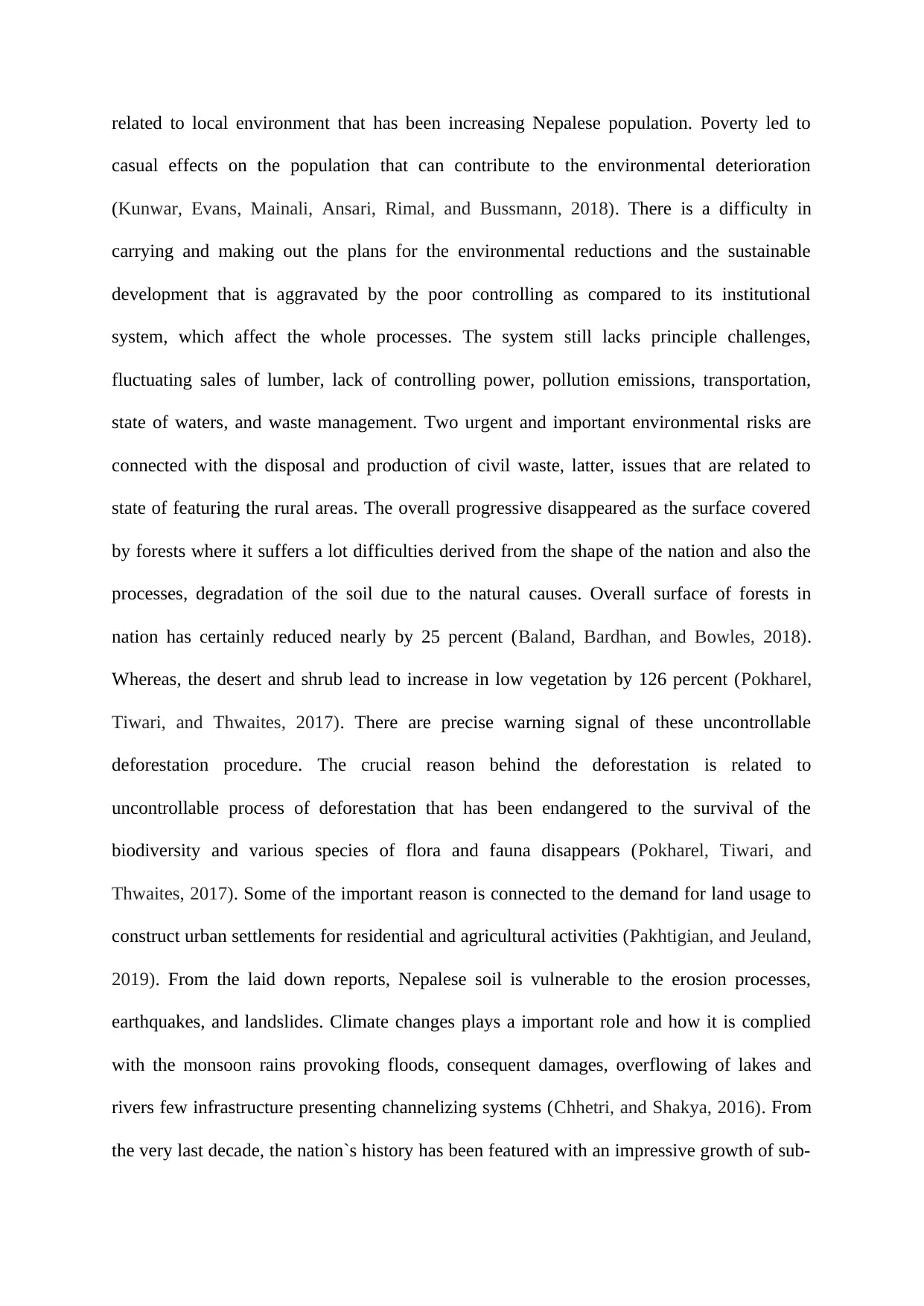
related to local environment that has been increasing Nepalese population. Poverty led to
casual effects on the population that can contribute to the environmental deterioration
(Kunwar, Evans, Mainali, Ansari, Rimal, and Bussmann, 2018). There is a difficulty in
carrying and making out the plans for the environmental reductions and the sustainable
development that is aggravated by the poor controlling as compared to its institutional
system, which affect the whole processes. The system still lacks principle challenges,
fluctuating sales of lumber, lack of controlling power, pollution emissions, transportation,
state of waters, and waste management. Two urgent and important environmental risks are
connected with the disposal and production of civil waste, latter, issues that are related to
state of featuring the rural areas. The overall progressive disappeared as the surface covered
by forests where it suffers a lot difficulties derived from the shape of the nation and also the
processes, degradation of the soil due to the natural causes. Overall surface of forests in
nation has certainly reduced nearly by 25 percent (Baland, Bardhan, and Bowles, 2018).
Whereas, the desert and shrub lead to increase in low vegetation by 126 percent (Pokharel,
Tiwari, and Thwaites, 2017). There are precise warning signal of these uncontrollable
deforestation procedure. The crucial reason behind the deforestation is related to
uncontrollable process of deforestation that has been endangered to the survival of the
biodiversity and various species of flora and fauna disappears (Pokharel, Tiwari, and
Thwaites, 2017). Some of the important reason is connected to the demand for land usage to
construct urban settlements for residential and agricultural activities (Pakhtigian, and Jeuland,
2019). From the laid down reports, Nepalese soil is vulnerable to the erosion processes,
earthquakes, and landslides. Climate changes plays a important role and how it is complied
with the monsoon rains provoking floods, consequent damages, overflowing of lakes and
rivers few infrastructure presenting channelizing systems (Chhetri, and Shakya, 2016). From
the very last decade, the nation`s history has been featured with an impressive growth of sub-
casual effects on the population that can contribute to the environmental deterioration
(Kunwar, Evans, Mainali, Ansari, Rimal, and Bussmann, 2018). There is a difficulty in
carrying and making out the plans for the environmental reductions and the sustainable
development that is aggravated by the poor controlling as compared to its institutional
system, which affect the whole processes. The system still lacks principle challenges,
fluctuating sales of lumber, lack of controlling power, pollution emissions, transportation,
state of waters, and waste management. Two urgent and important environmental risks are
connected with the disposal and production of civil waste, latter, issues that are related to
state of featuring the rural areas. The overall progressive disappeared as the surface covered
by forests where it suffers a lot difficulties derived from the shape of the nation and also the
processes, degradation of the soil due to the natural causes. Overall surface of forests in
nation has certainly reduced nearly by 25 percent (Baland, Bardhan, and Bowles, 2018).
Whereas, the desert and shrub lead to increase in low vegetation by 126 percent (Pokharel,
Tiwari, and Thwaites, 2017). There are precise warning signal of these uncontrollable
deforestation procedure. The crucial reason behind the deforestation is related to
uncontrollable process of deforestation that has been endangered to the survival of the
biodiversity and various species of flora and fauna disappears (Pokharel, Tiwari, and
Thwaites, 2017). Some of the important reason is connected to the demand for land usage to
construct urban settlements for residential and agricultural activities (Pakhtigian, and Jeuland,
2019). From the laid down reports, Nepalese soil is vulnerable to the erosion processes,
earthquakes, and landslides. Climate changes plays a important role and how it is complied
with the monsoon rains provoking floods, consequent damages, overflowing of lakes and
rivers few infrastructure presenting channelizing systems (Chhetri, and Shakya, 2016). From
the very last decade, the nation`s history has been featured with an impressive growth of sub-
⊘ This is a preview!⊘
Do you want full access?
Subscribe today to unlock all pages.

Trusted by 1+ million students worldwide
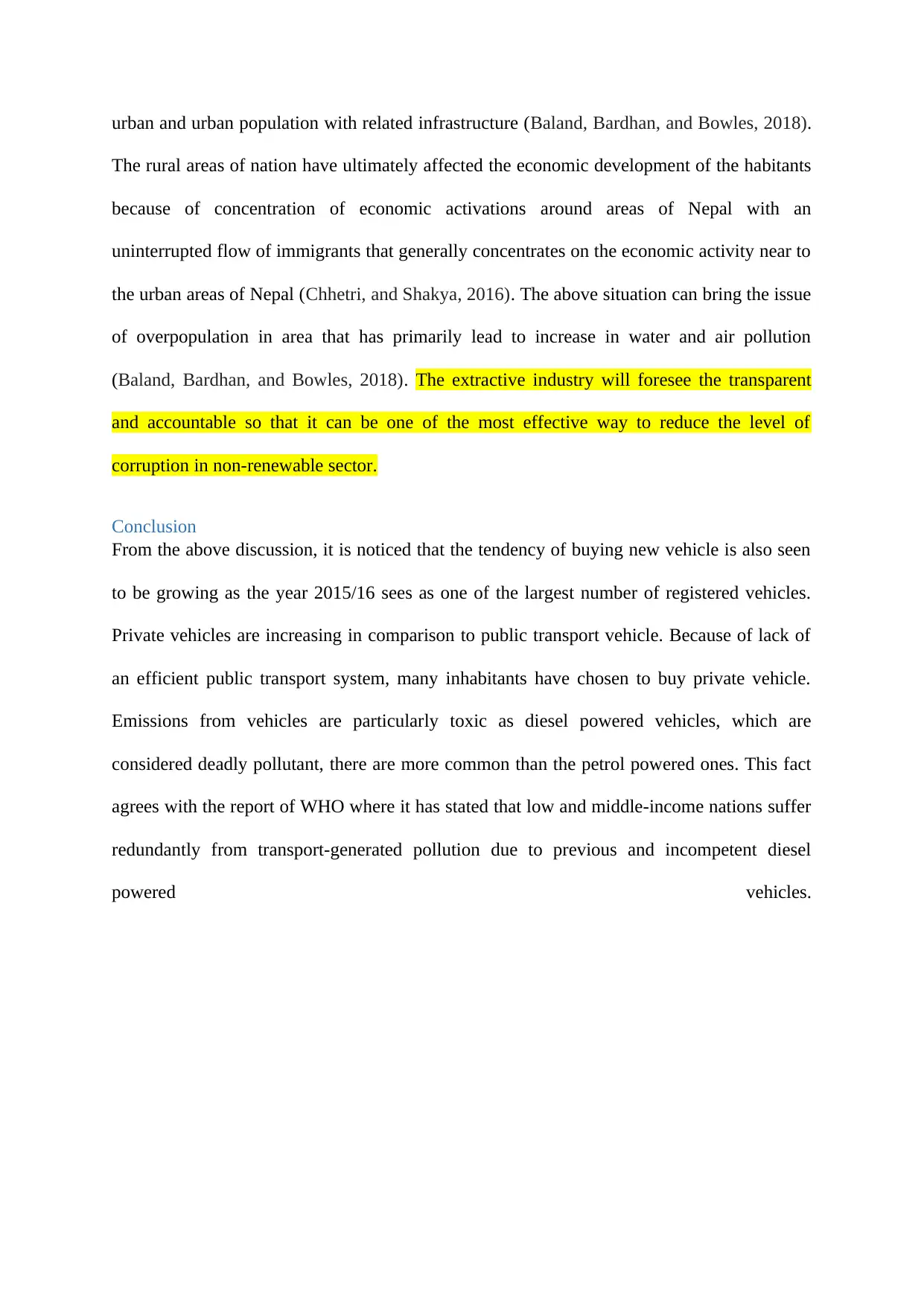
urban and urban population with related infrastructure (Baland, Bardhan, and Bowles, 2018).
The rural areas of nation have ultimately affected the economic development of the habitants
because of concentration of economic activations around areas of Nepal with an
uninterrupted flow of immigrants that generally concentrates on the economic activity near to
the urban areas of Nepal (Chhetri, and Shakya, 2016). The above situation can bring the issue
of overpopulation in area that has primarily lead to increase in water and air pollution
(Baland, Bardhan, and Bowles, 2018). The extractive industry will foresee the transparent
and accountable so that it can be one of the most effective way to reduce the level of
corruption in non-renewable sector.
Conclusion
From the above discussion, it is noticed that the tendency of buying new vehicle is also seen
to be growing as the year 2015/16 sees as one of the largest number of registered vehicles.
Private vehicles are increasing in comparison to public transport vehicle. Because of lack of
an efficient public transport system, many inhabitants have chosen to buy private vehicle.
Emissions from vehicles are particularly toxic as diesel powered vehicles, which are
considered deadly pollutant, there are more common than the petrol powered ones. This fact
agrees with the report of WHO where it has stated that low and middle-income nations suffer
redundantly from transport-generated pollution due to previous and incompetent diesel
powered vehicles.
The rural areas of nation have ultimately affected the economic development of the habitants
because of concentration of economic activations around areas of Nepal with an
uninterrupted flow of immigrants that generally concentrates on the economic activity near to
the urban areas of Nepal (Chhetri, and Shakya, 2016). The above situation can bring the issue
of overpopulation in area that has primarily lead to increase in water and air pollution
(Baland, Bardhan, and Bowles, 2018). The extractive industry will foresee the transparent
and accountable so that it can be one of the most effective way to reduce the level of
corruption in non-renewable sector.
Conclusion
From the above discussion, it is noticed that the tendency of buying new vehicle is also seen
to be growing as the year 2015/16 sees as one of the largest number of registered vehicles.
Private vehicles are increasing in comparison to public transport vehicle. Because of lack of
an efficient public transport system, many inhabitants have chosen to buy private vehicle.
Emissions from vehicles are particularly toxic as diesel powered vehicles, which are
considered deadly pollutant, there are more common than the petrol powered ones. This fact
agrees with the report of WHO where it has stated that low and middle-income nations suffer
redundantly from transport-generated pollution due to previous and incompetent diesel
powered vehicles.
Paraphrase This Document
Need a fresh take? Get an instant paraphrase of this document with our AI Paraphraser
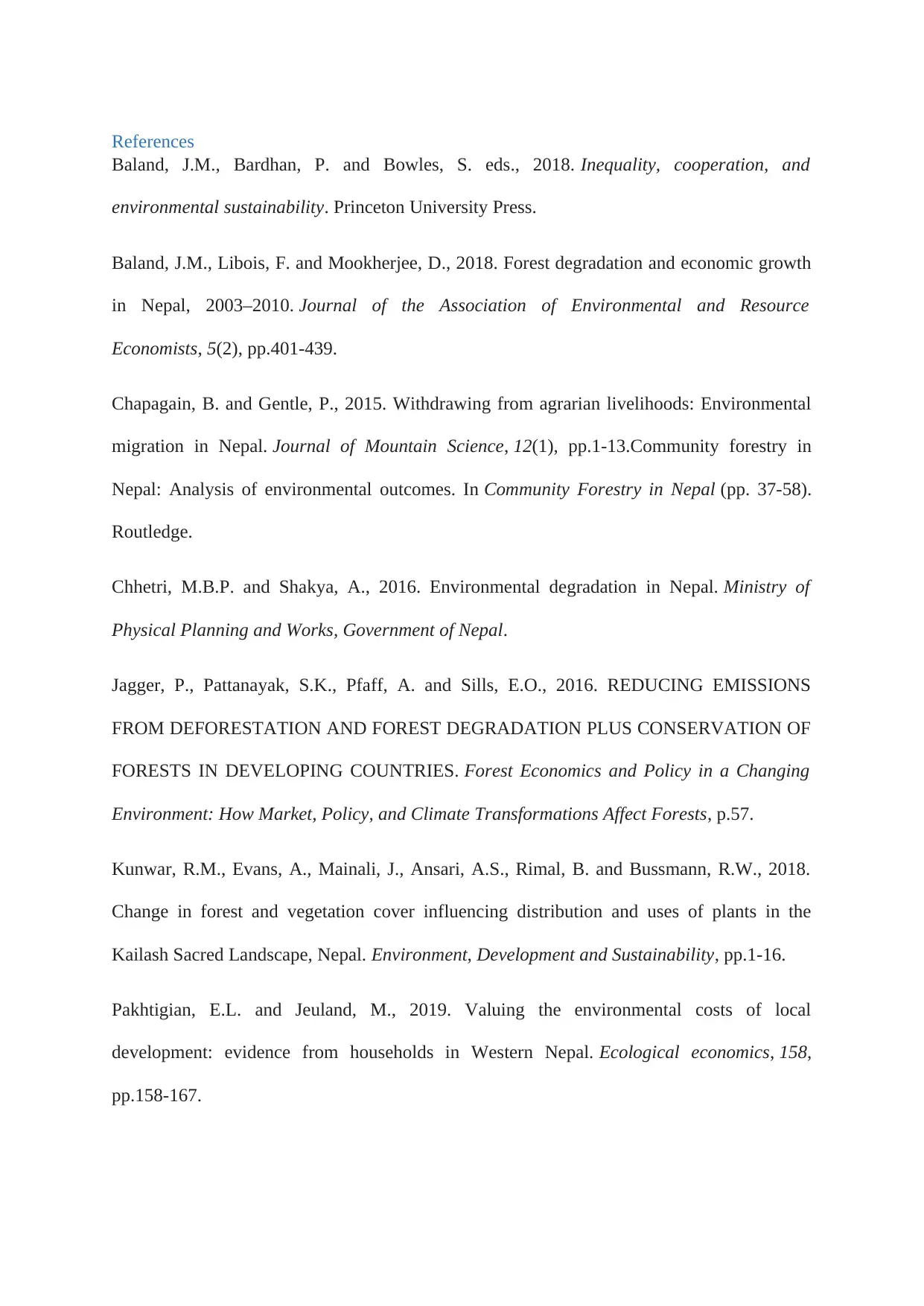
References
Baland, J.M., Bardhan, P. and Bowles, S. eds., 2018. Inequality, cooperation, and
environmental sustainability. Princeton University Press.
Baland, J.M., Libois, F. and Mookherjee, D., 2018. Forest degradation and economic growth
in Nepal, 2003–2010. Journal of the Association of Environmental and Resource
Economists, 5(2), pp.401-439.
Chapagain, B. and Gentle, P., 2015. Withdrawing from agrarian livelihoods: Environmental
migration in Nepal. Journal of Mountain Science, 12(1), pp.1-13.Community forestry in
Nepal: Analysis of environmental outcomes. In Community Forestry in Nepal (pp. 37-58).
Routledge.
Chhetri, M.B.P. and Shakya, A., 2016. Environmental degradation in Nepal. Ministry of
Physical Planning and Works, Government of Nepal.
Jagger, P., Pattanayak, S.K., Pfaff, A. and Sills, E.O., 2016. REDUCING EMISSIONS
FROM DEFORESTATION AND FOREST DEGRADATION PLUS CONSERVATION OF
FORESTS IN DEVELOPING COUNTRIES. Forest Economics and Policy in a Changing
Environment: How Market, Policy, and Climate Transformations Affect Forests, p.57.
Kunwar, R.M., Evans, A., Mainali, J., Ansari, A.S., Rimal, B. and Bussmann, R.W., 2018.
Change in forest and vegetation cover influencing distribution and uses of plants in the
Kailash Sacred Landscape, Nepal. Environment, Development and Sustainability, pp.1-16.
Pakhtigian, E.L. and Jeuland, M., 2019. Valuing the environmental costs of local
development: evidence from households in Western Nepal. Ecological economics, 158,
pp.158-167.
Baland, J.M., Bardhan, P. and Bowles, S. eds., 2018. Inequality, cooperation, and
environmental sustainability. Princeton University Press.
Baland, J.M., Libois, F. and Mookherjee, D., 2018. Forest degradation and economic growth
in Nepal, 2003–2010. Journal of the Association of Environmental and Resource
Economists, 5(2), pp.401-439.
Chapagain, B. and Gentle, P., 2015. Withdrawing from agrarian livelihoods: Environmental
migration in Nepal. Journal of Mountain Science, 12(1), pp.1-13.Community forestry in
Nepal: Analysis of environmental outcomes. In Community Forestry in Nepal (pp. 37-58).
Routledge.
Chhetri, M.B.P. and Shakya, A., 2016. Environmental degradation in Nepal. Ministry of
Physical Planning and Works, Government of Nepal.
Jagger, P., Pattanayak, S.K., Pfaff, A. and Sills, E.O., 2016. REDUCING EMISSIONS
FROM DEFORESTATION AND FOREST DEGRADATION PLUS CONSERVATION OF
FORESTS IN DEVELOPING COUNTRIES. Forest Economics and Policy in a Changing
Environment: How Market, Policy, and Climate Transformations Affect Forests, p.57.
Kunwar, R.M., Evans, A., Mainali, J., Ansari, A.S., Rimal, B. and Bussmann, R.W., 2018.
Change in forest and vegetation cover influencing distribution and uses of plants in the
Kailash Sacred Landscape, Nepal. Environment, Development and Sustainability, pp.1-16.
Pakhtigian, E.L. and Jeuland, M., 2019. Valuing the environmental costs of local
development: evidence from households in Western Nepal. Ecological economics, 158,
pp.158-167.

Qamer, F., Shehzad, K., Abbas, S., Murthy, M.S.R., Xi, C., Gilani, H. and Bajracharya, B.,
2016. Mapping deforestation and forest degradation patterns in western Himalaya,
Pakistan. Remote Sensing, 8(5), p.385.
Rai, R.K., Nepal, M., Karky, B.S., Somanathan, E., Timalsina, N., Khadayat, M.S. and
Bhattarai, N., 2017. Costs and benefits of reducing deforestation and forest degradation in
Nepal. ICIMOD Working Paper, (2017/5).
2016. Mapping deforestation and forest degradation patterns in western Himalaya,
Pakistan. Remote Sensing, 8(5), p.385.
Rai, R.K., Nepal, M., Karky, B.S., Somanathan, E., Timalsina, N., Khadayat, M.S. and
Bhattarai, N., 2017. Costs and benefits of reducing deforestation and forest degradation in
Nepal. ICIMOD Working Paper, (2017/5).
⊘ This is a preview!⊘
Do you want full access?
Subscribe today to unlock all pages.

Trusted by 1+ million students worldwide
1 out of 9
Related Documents
Your All-in-One AI-Powered Toolkit for Academic Success.
+13062052269
info@desklib.com
Available 24*7 on WhatsApp / Email
![[object Object]](/_next/static/media/star-bottom.7253800d.svg)
Unlock your academic potential
Copyright © 2020–2025 A2Z Services. All Rights Reserved. Developed and managed by ZUCOL.





